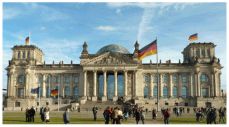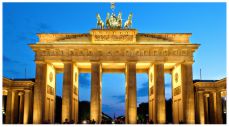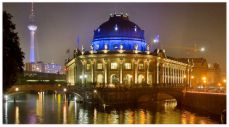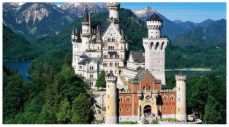Germany is blessed with some of Europe's most high-powered sights. There's spectacular scenery — the jagged Alps, flower-filled meadows, rolling hills of forests and farms, and mighty rivers — dotted all over with castles and churches of every variety. In Deutschland's idyllic half-timbered villages, you can enjoy strudel at the bakery or sip a stein of beer while men in lederhosen play oompah music. And don't overlook the “real” Germany of today — a world of high-tech trains, gleaming cities, social efficiency, and world-class museums celebrating many of history's greatest cultural achievements.
At a Glance
PLAN YOUR TOUR
3 Days:Munich, Bavarian castles 5 Days, add: Rhine Valley, Rothenburg 7 Days, add: More of Bavaria and Tirol, side-trip to Salzburg 10 Days, add:Berlin 14 Days, add:Baden-Baden, Black Forest, Dresden 17 Days, add:Nürnberg, Mosel Valley, Trier 21 Days, add:Würzburg, and slow down
With More Time:
Choose among Frankfurt, Cologne, Hamburg, Leipzig, and the Martin Luther towns (Erfurt and Wittenberg). This itinerary is designed to be done by car, but could be done by train with some modifications: Skip the southern Black Forest and take the train from Baden-Baden to Munich, which works well as a home base for visiting Bavaria and Salzburg. Then take the train or bus to Rothenburg; from there, Würzburg, Nürnberg, and Dresden are all on the way to Berlin. Or, for the best of both worlds, consider using trains to connect major cities, and then renting a car strategically to explore worthwhile countryside regions (such as Bavaria).
Things To Do:
*Munich Lively city with a traffic-free center, excellent museums, Baroque palaces, stately churches, rowdy beer halls, convivial beer gardens, and beautiful parks (such as the English Garden) — plus the sobering concentration camp memorial at nearby Dachau.
*Southern Bavaria and Western Tirol Pair of Alps-straddling regions (one in Germany, the other in Austria) boasting the fairy-tale castles of Neuschwanstein, Hohenschwangau, and Linderhof; inviting villages such as the handy home base Füssen, Austrian retreat Reutte, and adorable Oberammergau; the towering Zugspitze and its high-altitude lifts; and hiking, luge rides, and other mountain activities.
*Salzburg (Austria, just over the border) and Berchtesgaden Austrian musical mecca for fans of Mozart and The Sound of Music, offering a dramatic castle, concerts, Baroque churches, and an old town full of winding lanes; plus nearby Berchtesgaden, soaked in alpine scenery and Nazi history.
*Berlin Germany's vibrant capital, featuring world-class museums, gleaming modern architecture, and trendy nightlife, along with evocative monuments and reminders of the Wall that once divided the city and country.
*Rothenburg and the Romantic Road Well-preserved medieval city full of half-timbered buildings and cobbled lanes surrounded by walkable medieval walls; jumping-off point for the "Romantic Road" scenic route through lovely countryside and time-passed towns, including Dinkelsbühl and Nördlingen.
*Rhine Valley Mighty river steeped in legend, where storybook villages (including charming home-base towns Bacharach and St. Goar) cluster under imposing castles, such as Rheinfels and Marksburg.
*Mosel Valley Peaceful meandering river lined with tiny wine-loving cobbled towns, such as handy Cochem and quaint Beilstein, plus my favorite European castle, Burg Eltz.
*Nürnberg City with old-fashioned sandstone core and great museums, with reminders of Nazi past thoughtfully presented on the outskirts of town.
*Dresden Art-filled city offering exquisite museums, Baroque palaces, a pleasant riverside promenade, and hard memories of a notorious WWII firebombing.
*Baden-Baden and the Black Forest High-class resort/spa town of Baden-Baden, with decadent bath experiences, a peaceful riverside stroll, and a grand casino; lively university city of Freiburg and cozy village of Staufen; and a thickly forested countryside rife with healthy hikes, folk museums, cute hamlets, and cream cakes.
*Würzburg Home to the impressive Residenz palace (with manicured gardens and dazzling Rococo chapel) and lively wine bars.
*Frankfurt Europe's bustling banking center, offering a stunning skyscraper skyline and a look at today's Germany.
* Trier Germany's oldest city, with a lively pedestrian zone and imposing Roman monuments, including the Porta Nigra gate.
* Cologne Spectacular Gothic cathedral looming above a busy, museum-packed city on the Rhine River.
* Lutherland Charming university town of Erfurt, where Martin Luther spent his youth; Wartburg Castle, where he hid out from the pope's goons; and Wittenberg, where he taught, preached, and revolutionized Christianity.
* Leipzig Formerly derelict “second city” of East Germany, now rejuvenated (if architecturally dull) with excellent Bach and Cold War sights.
* Hamburg Big port city with emigration, World War II, and Beatles history — and Las Vegas-style nightlife.
When to Go
The "tourist season" runs roughly from May through September. Summer has its advantages: the best weather, snow-free alpine trails, very long days (light until after 21:00), and the busiest schedule of tourist fun. Travel during "shoulder season" (April, May, September, and early October) is easier and can be a bit less expensive. Shoulder-season travelers usually enjoy smaller crowds, decent weather, the full range of sights and tourist fun spots, and the ability to grab a room almost whenever and wherever they like — often at a flexible price. Also, in fall, fun harvest and wine festivals enliven many towns and villages, while forests and vineyards display beautiful fiery colors. Winter travelers find concert seasons in full swing, with absolutely no crowds, but some accommodations and sights are either closed or run on a limited schedule. Confirm your sightseeing plans locally, especially when traveling off-season. The weather can be cold and dreary, and nightfall draws the shades on sightseeing well before dinnertime. But dustings of snow turn German towns and landscapes into a wonderland, and December offers the chance to wander through Germany's famous Christmas markets (this tinseled fun often comes with higher hotel prices, but also longer museum hours).






